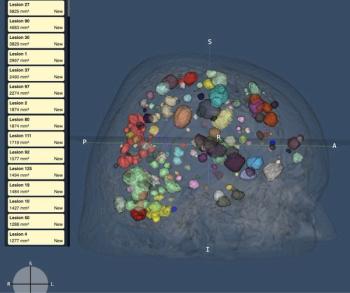
Can an Emerging PSMA/PET Agent Improve Detection of Prostate Cancer Recurrence in Patients with Low PSAs?
In a recent video interview from the American Urological Association (AUA) 2023 Annual Meeting, Brian Helfand, M.D., discussed emerging research that shows the potential viability of the agent F18-rhPSMA-7.3 for enhancing the detection of prostate cancer recurrence and facilitating earlier intervention for patients with low prostate-specific antigen (PSA) levels.
Approximately 40 to 50 percent of men will have prostate cancer recurrence over a 15 to 20-year period but the sensitivity in pinpointing locations of recurrence remains a significant limitation for conventional imaging such as computed tomography (CT), bone scans and magnetic resonance imaging (MRI), noted Brian Helfand, M.D., in a recent interview from the American Urological Association’s (AUA) 2023 Annual Meeting in Chicago.
“The success of conventional imaging is directly associated with the level of PSA (prostate-specific antigen). The higher the PSA, the more likely the conventional imaging can detect those sites of recurrence. But in general, the PSA has to be greater than 10 or 20 (ng/mL) for those modalities to pick up those sites of recurrence,” said Dr. Helfand, chief of the Division of Urology for the NorthShore University HealthSystem, and a clinical professor at the University of Chicago.
However, the emerging PSMA/PET agent 18F-rhPSMA-7.3 (Blue Earth Diagnostics/Bracco Imaging) may have promising utility for the diagnosis of prostate cancer recurrence in patients with lower PSA levels. In a subgroup analysis of 389 patients from the phase 3 SPOTLIGHT study who had been treated with primary radiation therapy, Dr. Helfand and colleagues found that out of 76 patients diagnosed with prostate cancer recurrence (with a median baseline PSA of 4.4 ng/mL), 18F-rhPSMA-7.3 had a detection rate of 76 percent for recurrence in the prostate bed and detected recurrence in distant extra-pelvic sites in 43 percent of patients.
(Editor’s note: For related content, see “
“The whole point of this scan is that it allows, at lower PSA levels, to detect where that (prostate recurrence) site is and helps us come up with a subsequent therapy that is most effective in those patients,” noted Dr. Helfand, who presented the research at the AUA conference. “It’s always a surprise when you have distant metastases … When that happens, that can definitely change how we think about treatment and the type of the treatment that patient will get.”
For more insights from Dr. Helfand, watch the video below.
Newsletter
Stay at the forefront of radiology with the Diagnostic Imaging newsletter, delivering the latest news, clinical insights, and imaging advancements for today’s radiologists.




